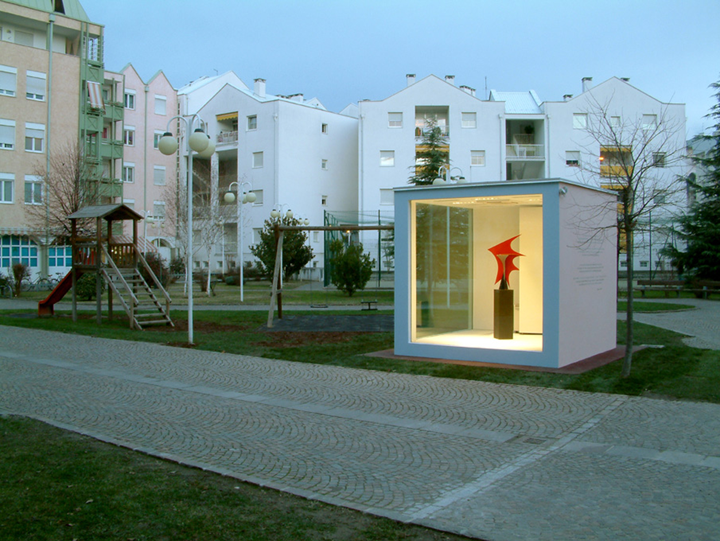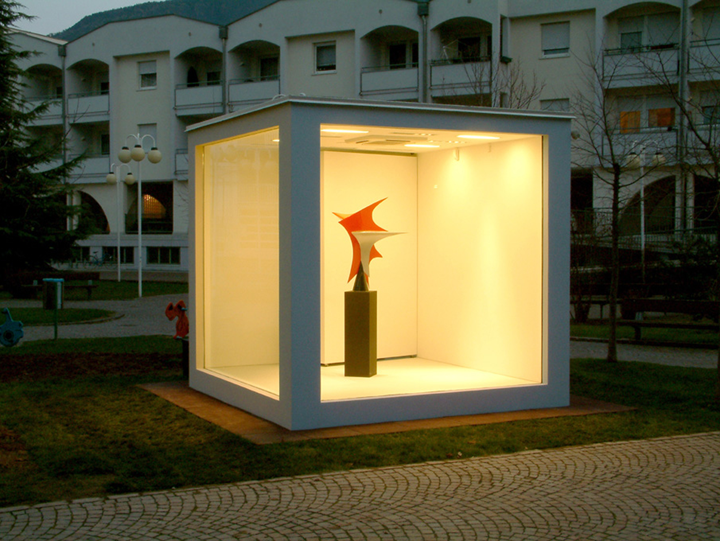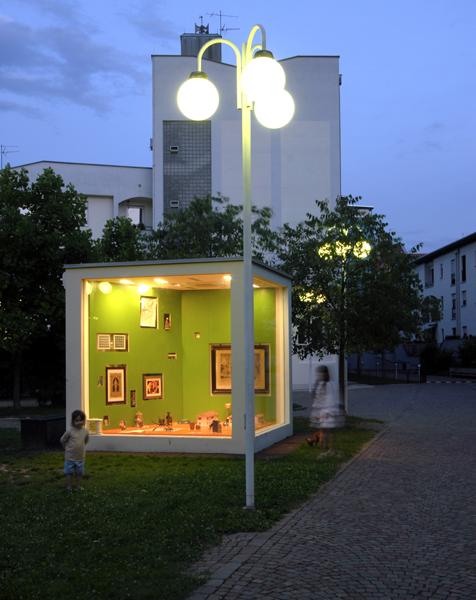“Arte sul territorio – Kunst und Territorium”, curated by L. Ragaglia, Quartiere Don Bosco, Bolzano, 2003
Little Museion
The Piccolo Museion is a cubical pavilion in concrete and glass located in the area of the playground of the Don Bosco neighborhood in Bolzano. The structure is used to display, in a three-month cycle, one work from the collection of the Museion – the Museum of Modern and Contemporary Art of Bolzano. It is not possible to enter the structure, but just to observe the work from the outside. Thanks to a sensor, the internal lighting turns on whenever someone approaches the pavilion.
The work is the result of thinking about the role of dialogue artistic interventions in public space are expected to establish with the surrounding urban and social context. For the artist, in fact, the encounter with the city represents an opportunity to fill his practice with an ethical value. Approaching an audience perhaps extraneous to the art system, he feels it is necessary to come down from the “pedestal” of his status as a creator, and to generate a work that can be the pivot point and the raison d’être of his connection with that audience, the beneficiaries of the work but also, indirectly, its clients.
To respond to the lack of interest in art that seemed to be widespread among the inhabitants of the Don Bosco neighborhood, the artist has proposed a platform where art, “subtracted” from the museum, attempt to construct an unprecedented relationship with the city: positioning an “annex” of the museum in an outlying part of the city, a process of decentralization of the art system is triggered that generates new, positive tensions between the center and the outskirts of the urban structure, the art system audience and citizens, the museum and the reality of the life of the city. The Piccolo Museion has functioned basically as a picklock for an often complicated procedure, that of making the approach to art more “confidential”, stimulating the development of an awareness of the gaze: anyone who passes the pavilion inevitably finds himself, in fact, playing the role of the spectator. The work is therefore presented as a cultural service for the local residents: the pavilion becomes an everyday object for the people of the neighborhood and “autogenerates” encounters: with other inhabitants, with the art public, and with art itself.
“Far from any form of populist demagogy – the artist explains – I call the process that leads to the completion of my projects ‘Macchiavellian’. […] In fact, on the one hand the work fits in and puts down roots in the social and geographical territory, while on the other it addresses the specific system of art, exploring its languages. For me, these two processes are inseparable” [Stefano Boeri, Alberto Garutti, Hans Ulrich Obrist, in Tre tentativi per un catalogo ragionato dell’opera di Alberto Garutti, Kaleidoscope Press, Milano, 2010, p. 13].
Since the Piccolo Museion is not based on any architectural-formal and structural specificity, the possibility of replication is intrinsic in its conception as an instrument of a “strategy”, namely that of inserting art in everyday life, by effecting a physical and cultural shift of the places set aside for its enjoyment.


